EU: Malting Barley Crop 2006 Situation: Statement of Euromalt, The Federation of European Maltsters

Euromalt, representing the E.U. Malting Industry, has decided to issue a memorandum on the challenges that are confronting the industry as a direct consequence of the disastrous 2006 European grain harvest. The decision to issue this memorandum was taken during an extraordinary Euromalt Malting Barley Committee that was held on the 8th of November in Brussels. Much has already been written and much will be written about the consequences of what happened during the month of August this year. In this brief memorandum we will try to explain what happened to our raw material, malting barley, and what will be the consequences for our industry.
- What happened.
In most of Western and Central Europe the months of June and July were particularly warm and extremely dry. We were all expecting problems with lower yields and perhaps high protein levels. The winter malting barley harvest in France and the U.K. was, luckily, completed in good conditions and the overall quality was good. The spring barley harvest started in Spain, S. England, France and parts of S.W. Germany in July. By the end of that month it was as good as finished in these regions. The spring malting barley harvest was disappointing from a quality and quantity point of view in Spain but in France it was better than expected. The only problems that were being reported were as expected high proteins. Slovakia and Hungary had also completed most of their harvests and there again results were not so bad. August arrived, holidays arrived and so did the rain.
The month of August this year in Europe was one of the wettest and the coldest in many years. The rainfall was particularly heavy in parts of Central Europe with more than 100 mms falling in just 2/3 days and all this water fell on grain that was not only ripe but extremely dry. Moisture contents of grain that was being harvested prior to the rain was astonishingly low ; below 12%.
The weather maps that follow are self explanatory:

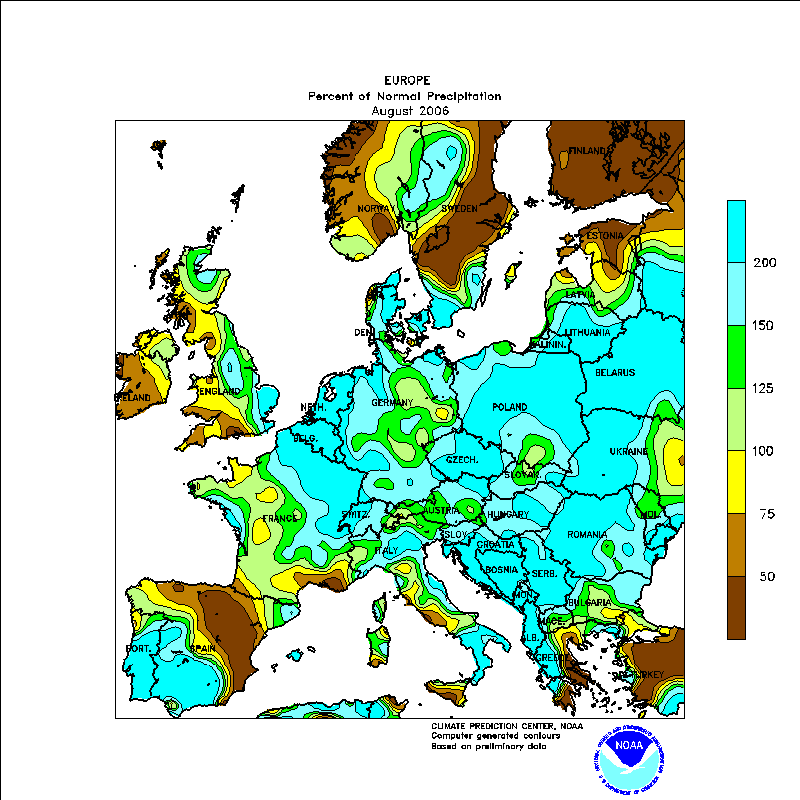
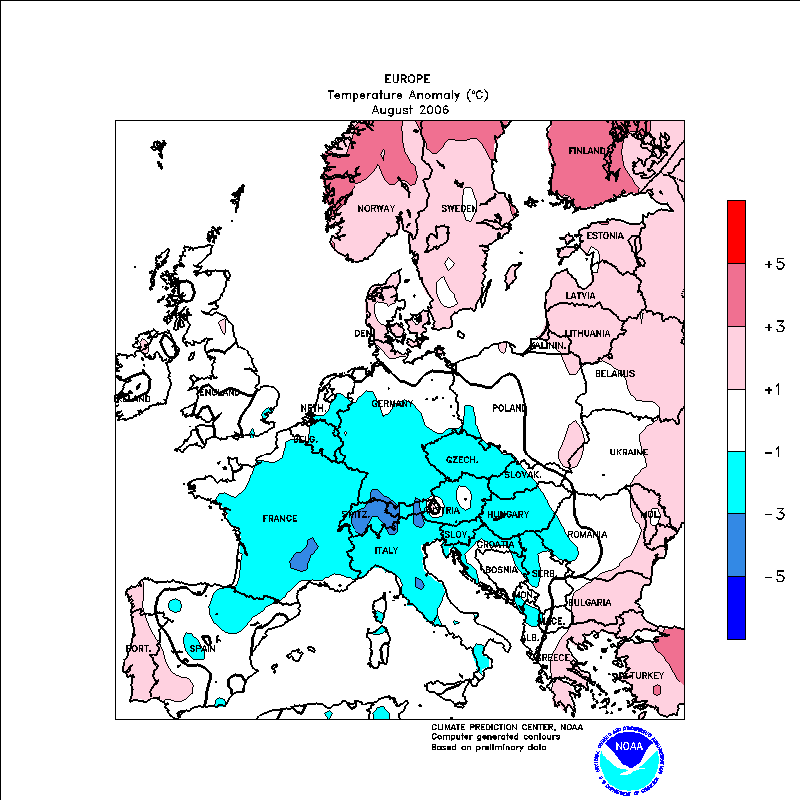
Barley will, under normal circumstances, support rainfall when it is already ripe and will not sprout as easily as wheat. This year was not a normal year. This year the heavy rain fell on barley that totally absorbed it like a sponge and began to sprout almost overnight. The barley that was by now well ripe was particularly vulnerable. The later barleys would have stood a better chance had the rain stopped, which it did not. By the end of the month of August huge quantities of European malting barley had been irrevocably lost.
In countries such as the Czech Republic, Poland and Germany these losses reached an incredibly high percentage ; between 50% and 75%. The quality of the barley that should have been malting barley was so bad that it could only be called feed barley with difficulty. Many other European countries were also affected by this phenomena to varying degrees. The map that follows tries to give a fairly accurate overall vision of to what degree individual countries suffered from this unusual amount of summer rainfall.
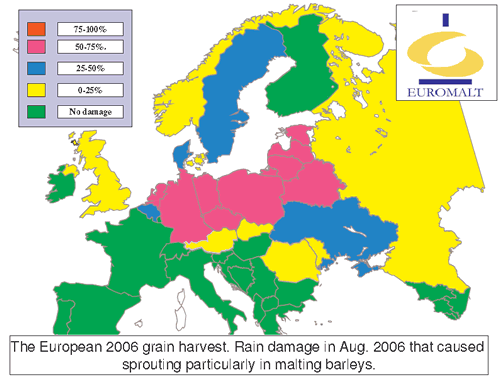
- 2 row spring malting barley fields early August 2006 somewhere in Central Europe !
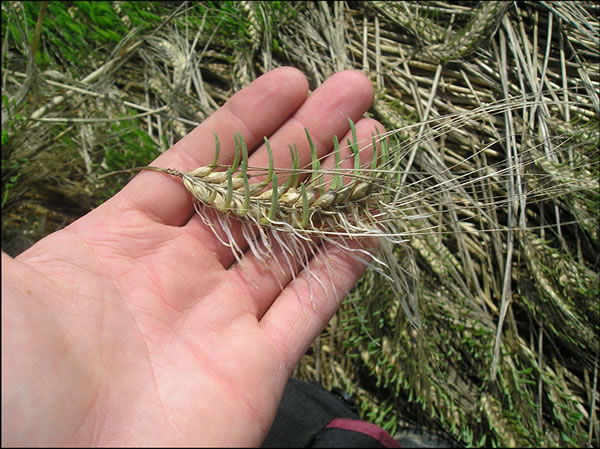
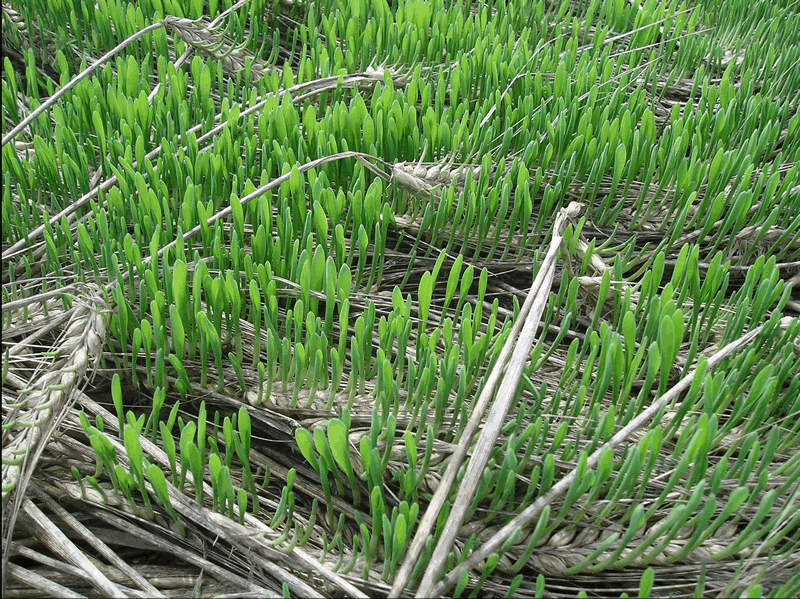
- The consequences.
Quantity and quality:
The first and the main consequence of this year’s disastrous crop is that our industry will have to deal with a basic shortage of malting barley, both spring and winter. If the industry uses the same quality criteria as it would in a normal year then there is simply not enough malting barley in Europe and consequently not enough malt to supply the industries concerned.
Today the industry is having to adapt to the situation and is working with brewers to find solutions. The malting industry and consequently the brewing industry will, in a very professional manner, be adjusting their quality criteria in order to accept malting barleys that would probably not be classed as malting barleys in normal years. The degree of flexibility that is needed is certainly going to vary from one country to another. In other problem years the damage is usually limited to a region or a country but the big difference this year is that it is almost a pan-European problem. A lot of malting barley is moving great distances in Europe to make up for losses in certain countries where the problem is the most severe.
European maltsters use both spring and winter malting barleys. The two big winter malting barley producers in Europe are the U.K. and France. The major winter malt producing countries are the U.K., France, Belgium and The Netherlands. In the first instance Maltsters that work in countries that do not normally use winter barleys, particularly the French 6 row varieties, will be now using them to make up for the spring barley losses.
It is important to point out at this stage that non E.U. malting barley imports are an impossible option this year. Our principle neighbour, the Ukraine, has had a disappointing crop quality wise and will only just have enough quality malting barley for the domestic demand. Russia has had a good crop but local demand has increased and this leaves little or no scope for exports. We think by now that all of the trade is aware of what is happening in Australia. The European malting industry can turn to no one for help and must therefore find a solution to their problem internally.
Over the past few years the rough average split of spring and winter malting barley usage by the European malting industry has been approximately 80% spring and 20% winter malting barley. That is not going to be possible this season. The figure this season will be closer to 70% spring and 30% winter. The question today is simple ; Is there enough winter malting barley available to fill the gap and reach the 30% share. The problem is that the answer may be, probably not. Barley that germinates, albeit in small quantities, may be necessary to allow the E.U. malting industry to work at full capacity.
In the following table we have drawn up an E.U. 25 malting barley supply & demand estimate for the 2006/07 season. This is an estimate based on cross Europe surveys and estimates from individual countries or companies. We have tried to make it as neutral and as honest as is possible today. This memorandum’s main objective is to clearly indicate the dilemma in which we find ourselves today. Estimates can and will vary slightly from one source to another but all will reach the same conclusion, there is a shortage of malting barley in the E.U.
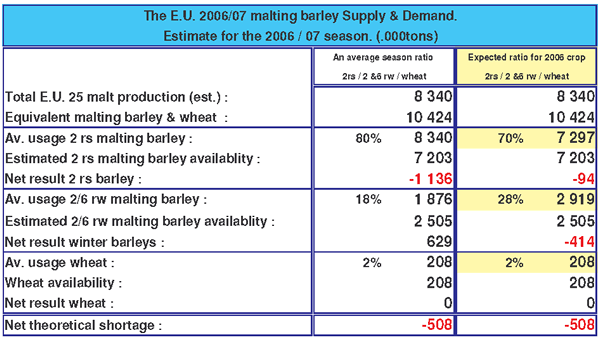
In theory the shortage that results from malting barley supply & demand estimate will have to be filled by lower quality barleys. This missing barley can be damaged spring malting barley or simply barley that germinates but that is not necessarily composed of traditional malting barley varieties.
The above figures are based on the assumption that all the ‘existing’ malting barley is still malting barley next spring. There are concerns in many areas of Europe about the potential loss in the germination capacity of barleys in areas where the harvest conditions were difficult.
It is perhaps also important to point out that the above S & D figures do not take into account any export trade. There has undoubtedly been some export business done and this will aggravate further the situation. This will concern both spring and winter malting barleys. Based on trade surveys it seems quite likely that the E.U. will export at least 300.000t of malting barley this season, 2 rs and 2 or 6 rw barley.
If one looks closely at the overall malt supply situation today in Europe, but also in the world, it is in both the maltster’s and the brewer’s interest to do their utmost to ensure that the E.U. malting industry is able to work at full capacity over the coming 12 months. If this means using lower quality barleys then so be it.
We think that it is true to say that nobody working in the business today, either maltster nor brewer, has ever had any experience dealing with the problem that confronts us now. In many countries
- The financial consequences.
It goes without saying that the E.U. malting industry has just gone through two particularly difficult years. The main reason for our difficulties was because of over capacity. That has now been solved and the industry has adapted itself to the new market.
It was hoped that we were now at the end of the tunnel. Unfortunately the crisis that the industry is facing due to a lack of barley supplies will also have a serious financial impact on our members. Nobody could have foreseen the disaster that occurred in August this year. It would be wrong to imagine that the malting industry had covered all its earlier sales. E.U. malting barley markets are notoriously thin and it is never possible to cover large volumes over short periods. When the markets started to move, the incredible speed at which they moved meant that the industry was locking in losses not profits from a very early stage.
- A summary.
Euromalt is not a maltster, it is a European trade association. We have tried to make this memorandum as neutral and as objective as is possible. Euromalt cannot and has no authority to intervene in any individual companies discussions with their clients. The aim therefore of these few pages is to publish a document that can be used as a support by any of our associations or their members in the contractual discussions that they make have during the season. It will also serve as a record of this year’s extremely unusual events, which we naturally hope not to see again.From an optimistic point of view this season’s events have at least taught us all a lesson.
That lesson is the fragility of our supply chain. Malting barley and consequently malt is a natural raw material and, like hops, the availability can be severely reduced by unfavourable weather. Tomorrow there are other threats to our supply chain such as the Bio fuel industry. This is another subject and an important one. During our Committee Meeting it was decided that Euromalt will also issue a memorandum on the subject of Bio Fuels and the impact that they could have on our industry. This memorandum will be published shortly.
Nicholas King.
President.
November 2006.
Committee participants Brussels 8.11.2006 :
Sweden & Lithuania :
Bengt Ohlsson (Viking Malt)
Germany :
Carl Otto Schill (Global Malt)
Luis Segura (Durst Malz)
Dietrich Mönch (Chairman Euromalt Technical
Committee. Global Malt.)
Michael Lerch (Deutscher Malzerbund)
Denmark :
Kim Fuglsang (Fuglsang)
Belgium :
Stefan Doms (Boortmalt)
Netherlands :
Freddy Dekkers (Holland Malt)
Italy & Czech Rep. :
Andries de Groen (SABMiller)
Finland :
Juhani Elonheimo (Raisio)
U.K. :
Tim Stonehouse (Muntons)
Roger Woodley (Bairds Malt)
Bob King (Crisp Maltings)
Colin West (Maltsters Association of Great Britain)
Ireland :
Steve le Poidevin (Greencore)
Poland & Hungary :
Nicholas King (Malteries Soufflet)
France : .
Stephane Lefort (Cargill)
Euromalt :
Henriette Christensen (Association Secretary)
29 November, 2006